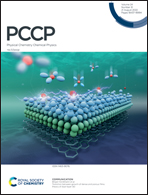High-throughput computational screening of hypothetical metal–organic frameworks with open copper sites for CO2/H2 separation†
Abstract
It is challenging to identify the optimal metal–organic framework (MOF) adsorbents for gas adsorption and membrane-based separation from the large-scale material databases. The high-throughput computational screening (HTCS) method was adopted to discover the optimal materials for CO2/H2 separation from thousands of MOFs. First, a hierarchical strategy was used to select 1092 MOFs from 13 512 MOFs, and their adsorption capacity towards the equimolar CO2/H2 mixture at 298 K and 10 bar was further calculated using the grand canonical Monte Carlo (GCMC) simulations. The results show that those MOFs with lvtb topology and organic linker 1,2,4,5-tetrazine are conducive to exhibiting high performance CO2/H2 adsorption separation among top-100 MOFs with high performance. The MOFs with pore limited diameter (PLD), largest cavity diameter (LCD), gravimetrical surface area (GSA), and void fraction in the range of 4–12 Å, 5–12 Å, 5500–6500 m2 g−1 and 0.80–0.85, respectively, have high adsorption capacity towards CO2. Second, the dynamic adsorption properties of the top-4 MOFs were simulated by the breakthrough curves of the binary (CO2/H2) and quinary (CO2/H2/CH4/CO/N2) mixtures in the fixed adsorption bed. MOF-4641 exhibits a high breakthrough time of 130 for the quinary mixture. Finally, the adsorption mechanism of CO2 in the top-4 MOFs was investigated by the radial distribution function (RDF), the mass center probability density distribution, etc. The atomic insights from HTCS and breakthrough curve predictions in this work will be helpful in developing novel porous materials and obtaining superior CO2 separation performance.



 Please wait while we load your content...
Please wait while we load your content...